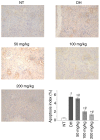Curcumin prevents renal cell apoptosis in acute kidney injury in a rat model of dry-heat environment heatstroke via inhibition of the mitochondrial apoptotic pathway
- PMID: 33376508
- PMCID: PMC7751465
- DOI: 10.3892/etm.2020.9558
Curcumin prevents renal cell apoptosis in acute kidney injury in a rat model of dry-heat environment heatstroke via inhibition of the mitochondrial apoptotic pathway
Abstract
Heatstroke is a life-threatening illness that is characterised by a core body temperature >40°C and central nervous system dysfunction. Acute kidney injury (AKI) is a common complication of heatstroke, and the mitochondrial apoptotic pathway has been demonstrated to be one of the leading causes of tissue damage and cell death in AKI. Curcumin is a phenol that is extracted from turmeric and demonstrates anti-apoptotic properties. To test if curcumin can protect the kidney from injury caused by heat stress, the effect of curcumin administration on renal injury and apoptosis of renal tissue was examined in a rat model of dry-heat environment. A total of 50 Sprague-Dawley rats were randomly divided into five groups (n=10): Standard temperature control, dry-heat control and curcumin treatment groups (50, 100 and 200 mg/kg groups). After exposure to a dry-heat environment for 150 min, the rats were anesthetized and euthanized. Blood, urine and renal tissue were collected to quantify the expression of specific mitochondrial apoptosis-related molecules. Curcumin pre-treatment decreased blood urea nitrogen and serum creatinine, urinary kidney injury molecule-1, and neutrophil gelatinase-associated lipocalin levels compared with the dry-heat control group. Curcumin was also revealed to downregulate c-Jun N-terminal kinases (JNK), cytochrome c, caspase-3 and caspase-9 expression upon treatment with 100 and 200 mg/kg curcumin, which may result in inhibition of the mitochondrial apoptotic pathway in renal cells. The current study revealed that Curcumin may to have potential for preventing heatstroke-induced AKI.
Keywords: acute kidney injury; curcumin; heatstroke; mitochondrial apoptotic pathway; rat model.
Copyright: © Zhao et al.
Figures





Similar articles
-
Curcumin alleviates acute kidney injury in a dry-heat environment by reducing oxidative stress and inflammation in a rat model.J Biochem Mol Toxicol. 2021 Jan;35(1):e22630. doi: 10.1002/jbt.22630. Epub 2020 Sep 12. J Biochem Mol Toxicol. 2021. PMID: 32918794 Free PMC article.
-
Curcumin alleviates heatstroke-induced liver injury in dry-heat environments by inhibiting the expression of NF-κB, iNOS, and ICAM-1 in rats.PLoS One. 2024 Sep 6;19(9):e0309598. doi: 10.1371/journal.pone.0309598. eCollection 2024. PLoS One. 2024. PMID: 39240880 Free PMC article.
-
Glutamine attenuates tubular cell apoptosis in acute kidney injury via inhibition of the c-Jun N-terminal kinase phosphorylation of 14-3-3.Crit Care Med. 2009 Jun;37(6):2033-44. doi: 10.1097/CCM.0b013e3181a005ba. Crit Care Med. 2009. PMID: 19384198
-
Heatstroke-induced acute kidney injury and the innate immune system.Front Med (Lausanne). 2023 Aug 8;10:1250457. doi: 10.3389/fmed.2023.1250457. eCollection 2023. Front Med (Lausanne). 2023. PMID: 37614951 Free PMC article. Review.
-
The pathogenesis and management of heatstroke and heatstroke-induced lung injury.Burns Trauma. 2025 Jan 14;13:tkae048. doi: 10.1093/burnst/tkae048. eCollection 2025. Burns Trauma. 2025. PMID: 39811431 Free PMC article. Review.
Cited by
-
Network Pharmacology and Metabolomics Reveal Anti-Ferroptotic Effects of Curcumin in Acute Kidney Injury.Drug Des Devel Ther. 2024 Dec 21;18:6223-6241. doi: 10.2147/DDDT.S486286. eCollection 2024. Drug Des Devel Ther. 2024. PMID: 39722679 Free PMC article.
-
Curcumin's Protective Role in Heatstroke-Induced Acute Liver Injury: Targeting Pyroptosis and Enhancing SIRT1 Expression.Glob Chall. 2024 Oct 13;8(12):2400178. doi: 10.1002/gch2.202400178. eCollection 2024 Dec. Glob Chall. 2024. PMID: 39679288 Free PMC article.
-
Curcumin ameliorates heatstroke-induced lung injury by activating the PI3K/AKT pathway.Naunyn Schmiedebergs Arch Pharmacol. 2025 Apr;398(4):4617-4632. doi: 10.1007/s00210-024-03572-z. Epub 2024 Nov 9. Naunyn Schmiedebergs Arch Pharmacol. 2025. PMID: 39521756
-
Antimicrobial Peptides Mediate Apoptosis by Changing Mitochondrial Membrane Permeability.Int J Mol Sci. 2022 Oct 22;23(21):12732. doi: 10.3390/ijms232112732. Int J Mol Sci. 2022. PMID: 36361521 Free PMC article. Review.
-
Organ-specific effects of curcumin on favipiravir-induced oxidative stress: renal benefit and hepatic risk.Naunyn Schmiedebergs Arch Pharmacol. 2025 Jul 21. doi: 10.1007/s00210-025-04458-4. Online ahead of print. Naunyn Schmiedebergs Arch Pharmacol. 2025. PMID: 40690012
References
-
- Bouchama A, Roberts G, Al Mohanna F, El-Sayed R, Lach B, Chollet-Martin S, Ollivier V, Al Baradei R, Loualich A, Nakeeb S, et al. Inflammatory, hemostatic, and clinical changes in a baboon experimental model for heatstroke. J Appl Physiol (1985) 2005;98:697–705. doi: 10.1152/japplphysiol.00461.2004. - DOI - PubMed
-
- Roberts GT, Ghebeh H, Chishti MA, Al-Mohanna F, El-Sayed R, Al-Mohanna F, Bouchama A. Microvascular injury, thrombosis, inflammation, and apoptosis in the pathogenesis of heatstroke: A study in baboon model. Arterioscler Thromb Vasc Biol. 2008;28:1130–1136. doi: 10.1161/ATVBAHA.107.158709. - DOI - PubMed
LinkOut - more resources
Full Text Sources
Research Materials
Miscellaneous
